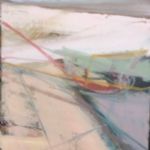PATH
Stour Valley Path - 25th Anniversary
This exhibition is North House Gallery’s contribution to the River Stour Festival and to the 25th Anniversary celebrations of the Stour Valley Path, organised by the Dedham Vale Area of Outstanding Natural Beauty and Stour Valley (AONB).
As a walker who has walked the Stour Valley Path twice, the curator is keen to encourage others to appreciate it in small or heroic stretches. Strictly speaking, the path starts at Cattawade at the top of the estuary and ends in Newmarket. We have allowed inclusion however of the path along the estuary, a section of the equally recommended Essex Way, which takes us to the mouth of the river at Harwich. The brief to the artists though was simply PATH, however they wanted to interpret it, so the results are remarkably diverse.
There are 13 artists in the show: Norman Ackroyd RA, Neil Bousfield, May Cornet, Jason Hicklin, Mel King, Kit Leese, Jane Lewis, Sarah Milne, Ruth Philo, Oliver Soskice, Dina Southwell, Jasper Startup, Linda Theophilus.
Norman Ackroyd has sent etchings of bucolic gates in snow or dappled summer light, of the pilgrims’ path up Croagh Patrick, Co. Mayo and a path through the snow at Sutton Bank in Yorkshire.
Neil Bousfield walks and draws every day along the fragile coast of Norfolk between Happisburgh and Walcott and then in the studio produces original engravings of remarkable complexity and emotional resonance. He has recently applied this treatment to the Norfolk Broads and to the impact of cable laying. Undergrounding of intrusive overhead wires is beginning to happen in the Stour Valley.
May Cornet's 'A Path Through the Woods' is a monoprint on three canvas panels two metres tall and altogether over four metres long. Her intricate quarry drawings also have paths creeping through them.
Jason Hicklin has etched Fox Covert in North Yorkshire in three versions. In the smallest one the wood looks menacing and impenetrable from the lighter outside; in the middle one the path is as lovely as a wooded path can be; and in the largest one, a diptych, the light in the centre leads the way out of the wood.
Melvyn King has taken PATH to mean the shipping lanes at Harwich. As well as ships in the distance plying the lanes there are colourful portraits of container ships named after the buoys which mark the way out of the estuary.
Kit Leese usually paints en plein air locally and has taken to the Stour Valley Path specifially for new paintings and etchings.
Jane Lewis always takes the landscape as the starting point for her abstract paintings in oil or watercolour. Paths are evident in the images and in the titles such as meeting point, more than one way, path uncertain and too wet!
Sarah Milne spends much of her time in Constable Country. Her two paintings in oil and pastel on board, Stour Valley Walking and Looking Across the Stour Valley, show her familiarity with the valley and the painter who inspired its protected status.
Ruth Philo, the originator and Chair of the River Stour Festival, is contributing new distinctive abstract, almost monochrome, paintings striated as in Tracks and with a notion of a path by a river in Borderline, referencing perhaps the Stour, which, for most of its length, is the border between Essex and Suffolk.
Oliver Soskice's abstract landscape paintings are always in some way airy and tranparent. His painting Blue Painting: Aerial Pathways is doubly so. The Way through the Page is an extraordinary depiction of a metaphorical path to understanding.
Dina Southwell depicts flight paths in her new silkscreen prints, a path along the estuary at Wrabness in a huge painting, and the shingle of the beach beside that path in collage.
Jasper Startup, the only sculptor, makes assemblages of wood, stone and other materials that he finds on his walks. The title of the elegant totem, Ordnance, is doubtless of military significance, but also brings to mind to the crucial Ordnance Survey maps for walkers.
Linda Theophilus has created a series of works called 'Colours of the Path', dyeing strips of silk and linen with her own natural dyes made from plant material gathered on significant days along the River Stour and the Stour Valley Path. From Copperas Bay, Wrabness on the spring equinox she achieved black from blackberry, sage greens from ivy, and browns from chestnut twigs. From Cattawade on Good Friday she extracted pale browns from ivy, yellow and beige, and a series of pale yellows from dandelion flowers. Finally on May Day the hawthorn (or may) produced a range of yellow: greenish through to orange. The final one was completed further up the valley on the summer solstice.
Maps of the Stour Valley Path available @ £5.00
Exhibition dates
-
Open on Saturdays, 10 am - 5 pm
These images are a selection of the works available at the Gallery
Please contact the gallery for further information.













